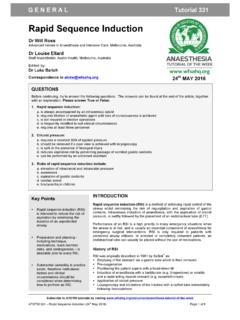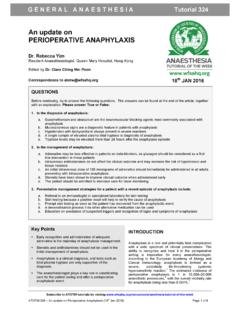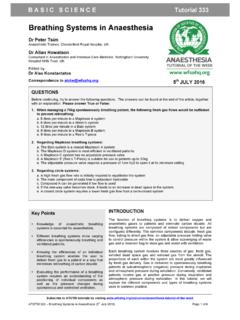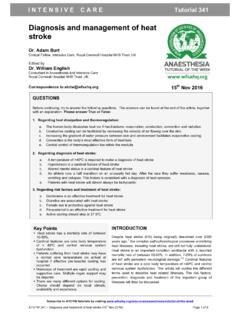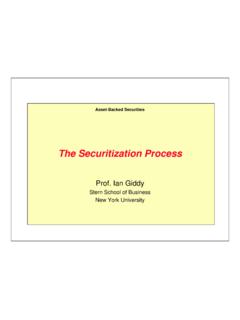Transcription of 331 Rapid Sequence Induction - anaesthesiology.gr
1 GENERAL Tutorial 331. Rapid Sequence Induction Dr Will Ross Advanced trainee in Anaesthesia and Intensive Care, Melbourne, Australia Dr Louise Ellard Staff Anaesthetist, Austin Health, Melbourne, Australia Edited by: Dr Luke Baitch Correspondence to 24th MAY 2016. QUESTIONS. Before continuing, try to answer the following questions. The answers can be found at the end of the article, together with an explanation. Please answer True or False: 1. Rapid Sequence Induction : a. is always accompanied by an intravenous opioid b. requires titration of anaesthetic agent until loss of consciousness is achieved c. is not required in elective operations d. is frequently modified to suit clinical circumstances e.
2 Requires at least three personnel 2. Cricoid pressure: a. requires a constant 30N of applied pressure b. should be removed if a poor view is achieved with laryngoscopy c. is safe in the presence of laryngeal injury d. reduces aspiration risk by preventing passage of vomited gastric contents e. can be performed by an untrained assistant 3. Risks of Rapid Sequence Induction include: a. elevation of intracranial and intraocular pressure b. awareness c. aspiration of gastric contents d. cardiac arrest e. bradycardia,in children INTRODUCTION. Key Points Rapid Sequence Induction (RSI) is a method of achieving Rapid control of the Rapid Sequence Induction (RSI) airway whilst minimising the risk of regurgitation and aspiration of gastric is intended to reduce the risk of contents.
3 Intravenous Induction of anaesthesia, with the application of cricoid aspiration by minimising the pressure, is swiftly followed by the placement of an endotracheal tube (ETT). duration of an unprotected airway. Performance of an RSI is a high priority in many emergency situations when the airway is at risk, and is usually an essential component of anaesthesia for emergency surgical interventions. RSI is only required in patients with preparation and planning - preserved airway reflexes. In arrested or completely obtunded patients, an including technique, endotracheal tube can usually be placed without the use of medications. medications, team member roles, and contingencies is History of RSI.
4 Desirable prior to every RSI. 1. RSI was originally described in 1961 by Sellick as: Emptying of the stomach via a gastric tube which is then removed Substantial variability in practice Pre-oxygenation exists, therefore institutional Positioning the patient supine with a head-down tilt factors and clinical Induction of anaesthesia with a barbiturate ( thiopentone) or volatile, circumstances should be and a Rapid -acting muscle relaxant ( suxamethonium). considered when determining Application of cricoid pressure how to perform an RSI. Laryngoscopy and intubation of the trachea with a cuffed tube immediately following fasciculations Subscribe to ATOTW tutorials by visiting th ATOTW 331 Rapid Sequence Induction (24 May 2016) Page 1 of 8.
5 The above classic method is now very rarely followed in full. In current clinical practice, a number of modifications have been made to the traditional RSI technique (Figure 1). The term modified RSI' is sometimes used to describe such variations but this term lacks a commonly accepted definition. Common modifications Omitting the placement of an oesophageal tube Supine or ramped positioning Titrating the dose of Induction agent to loss of consciousness Use of propofol, ketamine, midazolam or etomidate to induce anaesthesia Use of high-dose rocuronium as a neuromuscular blocking agent Omitting cricoid pressure Figure 1: Modifications of RSI technique in current practice CRICOID PRESSURE.
6 Cricoid pressure is the application of force to the cricoid cartilage of the patient (Figure 2). The rationale is that the upper oesophagus is occluded by being compressed between the trachea and the cervical vertebrae, preventing passive reflux of gastric contents and subsequent development of aspiration pneumonitis. 10 Newtons of force is applied by the thumb and index finger of an assistant increasing to 30N once consciousness is lost. (10N is the equivalent of around 1kg of pressure.) This pressure is maintained until endotracheal tube placement is confirmed. Cricoid pressure should be reduced or released if laryngoscopy is difficult, or if vomiting occurs (to reduce the chance of oesophageal rupture from active vomiting).
7 Figure 2: Surface anatomy for cricoid pressure INDICATIONS. RSI is indicated in patients who require endotracheal intubation and are at increased risk of reflux and aspiration of gastric contents. This means that RSI is almost universally required in situations calling for emergent endotracheal intubation. In fact, non-RSI intubation is almost exclusively the domain of the elective operating environment. Patient factors may dictate the need for certain elements of the RSI to be modified or omitted. Contraindications to suxamethonium such as allergy, susceptibility to malignant hyperthermia or hyperkalaemia should prompt usage of an 2. alternative muscle relaxant such as high-dose rocuronium.
8 A laryngeal injury contra-indicates cricoid pressure. Unstable cervical spine fractures will require caution in the application of cricoid pressure due to the possibility of exacerbating 3. damage. Subscribe to ATOTW tutorials by visiting th ATOTW 331 Rapid Sequence Induction (24 May 2016) Page 2 of 8. Indications for RSI. Unfasted patient or unknown fasting status trauma patients, emergency surgery, resuscitation situations and in patients with a reduced conscious level Known gastro-oesophageal reflux such as due to hiatus hernia Conditions leading to delayed gastric emptying autonomic gastroparesis (diabetes, Parkinson's disease), history of gastric banding surgery, patient in severe pain or with recent administration of opioids Pregnancy (from the second trimester onwards).
9 preparation . preparation is vital, both of equipment and team members particularly if the team is unfamiliar with the environment or their colleagues. Anticipation of difficult airway and establishing oxygenation plans prior to conducting RSI are essential. Many organisations advocate the use of a checklist to ensure that all equipment is available and in working order, and that the planned Sequence of events is shared with all team members. An example of an emergency intubation checklist is shown in figure 3. EMERGENCY INTUBATION CHECKLIST. PREPARE PATIENT PREPARE EQUIPMENT PREPARE FOR DIFFICULTY PREPARE TEAM. Monitoring Oxygen Supply Prepare for di cult airway if Con rm roles Pulse oximeter an>cipated Intubator BP (every 2 min) Airway equipment VDO laryngoscope Drugs Capnography Facemask LMA Cricoid pressure ECG Airway adjuncts Cricothyroidotomy kit In-line stabilisa=on Self-in a=ng bag (C-spine injury).
10 Op>mal posi>oning 2 laryngscopes Di cult airway trolley present Ramping in obese pa=ent Appropriate ET tubes Senior help accessible 30 head up for head injury Bougie or stylet Oxygena>on plan in event of Neck immobilisa=on for Suc=on failed intuba>on suspected C-spine injury Tube tape or =e Other speci c problems Good IV access with uid Drugs an>cipated? running RSI drugs Vassopressor Adequate preoxygenta>on Maintenance of seda=on and paralysis PROCEED TO RSI WHEN ALL CHECKS CONFIRMED. Figure 3: A checklist used in preparation for emergency intubation to ensure that drugs and equipment are available and that all team members are aware of their roles and the planned Sequence of events preparation of patient Explanation should be offered to the patient, providing a description of the planned technique including cricoid pressure.
